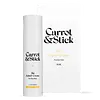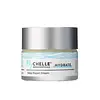What's inside
What's inside
 Key Ingredients
Key Ingredients

 Benefits
Benefits

 Concerns
Concerns

 Ingredients Side-by-side
Ingredients Side-by-side

Water
Skin ConditioningCaprylic/Capric Triglyceride
MaskingLactobacillus Ferment
Skin ConditioningCetearyl Olivate
Cetearyl Alcohol
EmollientButyrospermum Parkii Butter
Skin ConditioningMacadamia Ternifolia Seed Oil
EmollientCocos Nucifera Oil
MaskingSimmondsia Chinensis Seed Oil
EmollientHelianthus Annuus Seed Oil
EmollientPropanediol
SolventCucumis Sativus Fruit Extract
EmollientCamellia Sinensis Leaf Extract
AntimicrobialAloe Barbadensis Leaf Extract
EmollientChamomilla Recutita Flower Extract
MaskingHyaluronic Acid
HumectantNiacinamide
SmoothingPanthenol
Skin ConditioningTocopheryl Acetate
AntioxidantEthylhexylglycerin
Skin ConditioningPhenoxyethanol
PreservativeXanthan Gum
EmulsifyingWater, Caprylic/Capric Triglyceride, Lactobacillus Ferment, Cetearyl Olivate, Cetearyl Alcohol, Butyrospermum Parkii Butter, Macadamia Ternifolia Seed Oil, Cocos Nucifera Oil, Simmondsia Chinensis Seed Oil, Helianthus Annuus Seed Oil, Propanediol, Cucumis Sativus Fruit Extract, Camellia Sinensis Leaf Extract, Aloe Barbadensis Leaf Extract, Chamomilla Recutita Flower Extract, Hyaluronic Acid, Niacinamide, Panthenol, Tocopheryl Acetate, Ethylhexylglycerin, Phenoxyethanol, Xanthan Gum
Water
Skin ConditioningHelianthus Annuus Seed Oil
EmollientCaprylic/Capric Triglyceride
MaskingSqualane
EmollientGlycerin
HumectantCetearyl Olivate
Butyrospermum Parkii Butter
Skin ConditioningRibes Nigrum Seed Oil
EmollientThermus Thermophillus Ferment
Skin ConditioningCetearyl Alcohol
EmollientSaccharomyces/Xylinum/Black Tea Ferment
Skin ConditioningPolysorbate 60
EmulsifyingRosa Canina Fruit Oil
EmollientC18-36 Acid Triglyceride
EmollientSorbitan Olivate
EmulsifyingSimmondsia Chinensis Seed Oil
EmollientBrassica Campestris Seed Oil
Skin ConditioningXanthan Gum
EmulsifyingPhenethyl Alcohol
MaskingLycium Barbarum Fruit Extract
AstringentLonicera Japonica Flower Extract
Skin ConditioningCaprylyl Glycol
EmollientAcacia Senegal Gum
MaskingCitric Acid
BufferingLonicera Caprifolium Flower Extract
PerfumingPotassium Sorbate
PreservativePelargonium Graveolens Flower Oil
MaskingHamamelis Virginiana Water
AstringentLevisticum Officinale Oil
MaskingCarbomer
Emulsion StabilisingHydroxyethylcellulose
Emulsion StabilisingTocotrienols
Skin ConditioningElaeis Guineensis Oil
EmollientRosa Damascena Flower Oil
MaskingAlcohol
AntimicrobialTrisodium Ethylenediamine Disuccinate
Sodium Hydroxide
BufferingCitrus Aurantium Dulcis Flower Oil
AstringentTocopherol
AntioxidantAloe Barbadensis Leaf Juice Powder
Skin ConditioningCrocus Chrysanthus Bulb Extract
Skin ConditioningWater, Helianthus Annuus Seed Oil, Caprylic/Capric Triglyceride, Squalane, Glycerin, Cetearyl Olivate, Butyrospermum Parkii Butter, Ribes Nigrum Seed Oil, Thermus Thermophillus Ferment, Cetearyl Alcohol, Saccharomyces/Xylinum/Black Tea Ferment, Polysorbate 60, Rosa Canina Fruit Oil, C18-36 Acid Triglyceride, Sorbitan Olivate, Simmondsia Chinensis Seed Oil, Brassica Campestris Seed Oil, Xanthan Gum, Phenethyl Alcohol, Lycium Barbarum Fruit Extract, Lonicera Japonica Flower Extract, Caprylyl Glycol, Acacia Senegal Gum, Citric Acid, Lonicera Caprifolium Flower Extract, Potassium Sorbate, Pelargonium Graveolens Flower Oil, Hamamelis Virginiana Water, Levisticum Officinale Oil, Carbomer, Hydroxyethylcellulose, Tocotrienols, Elaeis Guineensis Oil, Rosa Damascena Flower Oil, Alcohol, Trisodium Ethylenediamine Disuccinate, Sodium Hydroxide, Citrus Aurantium Dulcis Flower Oil, Tocopherol, Aloe Barbadensis Leaf Juice Powder, Crocus Chrysanthus Bulb Extract
Ingredients Explained
These ingredients are found in both products.
Ingredients higher up in an ingredient list are typically present in a larger amount.
This ingredient is also known as shea butter. It is an effective skin hydrator and emollient.
Emollients help soothe and soften your skin. It does this by creating a protective film on your skin. This barrier helps trap moisture and keeps your skin hydrated. Emollients may be effective at treating dry or itchy skin.
Shea butter is rich in antioxidants. Antioxidants help fight free-radicals, or molecules that may harm the body. It is also full of fatty acids including stearic acid and linoleic acid. These acids help replenish the skin and keep skin moisturized.
While Shea Butter has an SPF rating of about 3-4, it is not a sunscreen replacement.
Shea butter may not be fungal acne safe. We recommend speaking with a professional if you have any concerns.
Learn more about Butyrospermum Parkii ButterThis ingredient is an emollient, solvent, and texture enhancer. It is considered a skin-softener by helping the skin prevent moisture loss.
It helps thicken a product's formula and makes it easier to spread by dissolving clumping compounds.
Caprylic Triglyceride is made by combining glycerin with coconut oil, forming a clear liquid.
While there is an assumption Caprylic Triglyceride can clog pores due to it being derived from coconut oil, there is no research supporting this.
Learn more about Caprylic/Capric TriglycerideCetearyl alcohol is a mixture of two fatty alcohols: cetyl alcohol and stearyl alcohol. It is mainly used as an emulsifier. Emulsifiers help prevent the separation of oils and products. Due to its composition, it can also be used to thicken a product or help create foam.
Cetearyl alcohol is an emollient. Emollients help soothe and hydrate the skin by trapping moisture.
Studies show Cetearyl alcohol is non-toxic and non-irritating. The FDA allows products labeled "alcohol-free" to have fatty alcohols.
This ingredient is usually derived from plant oils such as palm, vegetable, or coconut oils. There is debate on whether this ingredient will cause acne.
Due to the fatty acid base, this ingredient may not be Malassezia folliculitis safe.
Learn more about Cetearyl AlcoholCetearyl Olivate is an emulsifier and texture enhancer. It is derived from the fatty acids of olive oil and Cetearyl alcohol, and is biodegradable.
As an emulsifier, it is used to prevent oils and waters from separating. It can also
Manufacturers use the name Olivem 1000. This ingredient has been found to preserve the natural microbiome of skin. Having a healthy microbiome helps keep our skin healthy and protects against harmful bacteria. This ingredient is grouped with Sorbitan Olivate under the name Olivem 1000.
Learn more about Cetearyl OlivateHelianthus Annuus Seed Oil is the oil derived from the seeds of a Sunflower. Sunflower seed oil is non-fragrant. It is an emollient, meaning it helps to soften the skin.
Sunflower seed oil contains many fatty acids. The fatty acids found in sunflower seeds include (from highest amount to least): linoleic acid, myristic acid, palmitic acid, stearic acid, arachidic acid, oleic acid, and linolenic acid.
These fatty acids help the skin create ceramides. Ceramides play a role in repairing the skin barrier.
Helianthus Annuus Seed Oil helps moisturize the skin. This in turn helps the skin look more rejuvenated and smoother.
Sunflowers are rich in vitamin E.
Historians believe Indigenous cultures of North America domesticated sunflowers before corn. Thus they relied on sunflower oil for a variety of uses. One such use is moisturizing skin and hair.
Sunflower seed oil may not be fungal acne safe. We recommend speaking with a professional if you have any concerns.
Learn more about Helianthus Annuus Seed OilThis oil comes from the seeds of the desert shrub called Jojoba. It is more commonly known as jojoba oil, a non-comedogenic oil.
Jojoba oil does not contain fragrance and has many fatty-acids, making it a great soothing ingredient.
It also contains Vitamin E, a great moisturizing ingredient. Vitamin E is also an antioxidant and protects your skin against oxidative damage.
This ingredient humectant properties, meaning it helps draw moisture from the air. This helps keep your skin hydrated.
While jojoba has antibacterial properties, it is only able to kill some strains of bacteria.
Studies also show it helps in wound healing. In fact, Indigenous cultures have used jojoba as a moisturizer and to help treat burns for centuries.
Fun fact: Jojoba oil similar to natural human skin sebum, so it has a great effect on dry skin. It is also promising with helping to regulate sebum production.
Due to its fatty acid content, Jojoba oil may not be fungal acne safe. We recommend speaking with a professional if you have any concerns.
Learn more about Simmondsia Chinensis Seed OilWater. It's the most common cosmetic ingredient of all. You'll usually see it at the top of ingredient lists, meaning that it makes up the largest part of the product.
So why is it so popular? Water most often acts as a solvent - this means that it helps dissolve other ingredients into the formulation.
You'll also recognize water as that liquid we all need to stay alive. If you see this, drink a glass of water. Stay hydrated!
Learn more about WaterXanthan gum is used as a stabilizer and thickener within cosmetic products. It helps give products a sticky, thick feeling - preventing them from being too runny.
On the technical side of things, xanthan gum is a polysaccharide - a combination consisting of multiple sugar molecules bonded together.
Xanthan gum is a pretty common and great ingredient. It is a natural, non-toxic, non-irritating ingredient that is also commonly used in food products.
Learn more about Xanthan Gum